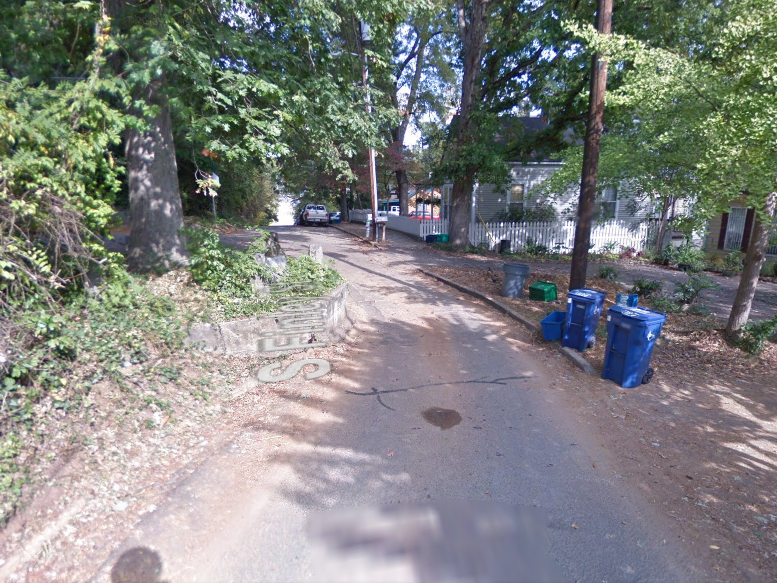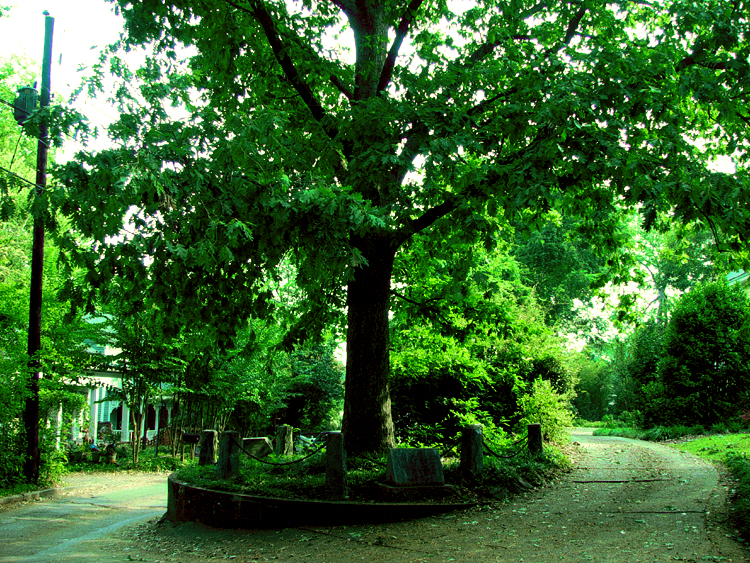The Tree That Owns Itself

The image above is what you’d see if you were on South Finley Street in Athens, Georgia, approaching Dearing Street (via Google Maps). You’ll note that right before Dearing Street, a large oak tree causes the corner to jut out into Finley, causing a bottleneck. The Red & Black (a University of Georgia publication) notes that the tree “precariously dwells within the street and makes the road a single lane, yet cars from both ways access the route,” and further describes the tree’s location as “hazardous.” One would think that the city of Athens would, therefore, remove the tree, and that the tree’s owner could easily be convinced that this was the right thing to do (or compensated otherwise). But that hasn’t happened.The problem?
The tree owns itself. It inherited itself from its dad, which was also a tree.
The story dates back nearly two hundred years ago. An Athens local named William Henry Jackson — by some reports a colonel and by others a professor (and it’s possible that he was both) — owned a home near the tree in question. According to legend, was fond of the tree — he claimed that, as a child, he relied on it for a spot of shade on hot days — and wanted to ensure that it would be around for generations to come. The details of his plan to do this are hazy because they weren’t reported until 1890, when a local newspaper called the Athens Weekly Banner ran a story on the tree — and Jackson’s gift of itself to it. The paper reported that sometime in the 1820s or early 1830s, Jackson issued the following deed (via Wikipedia):
I, W. H. Jackson, of the county of Clarke, of the one part, and the oak tree … of the county of Clarke, of the other part: Witnesseth, That the said W. H. Jackson for and in consideration of the great affection which he bears said tree, and his great desire to see it protected has conveyed, and by these presents do convey unto the said oak tree entire possession of itself and of all land within eight feet of it on all sides.
And as a result, the tree on the corner of Dearing and Finley owned itself. Kind of.
Whether the deed actually existed is unknown, and even if it did, it almost certainly has no legal bearing — in general, a conveyance of land to another party only works if that party accepts and receives the property, which is hard to do when you (the tree) are the property itself. But the Athens community has honored the bequest ever since. In 1906, famed philanthropist George Foster Peabody “paid to have new soil, a commemorative tablet, and a chain barricade supported by eight granite posts installed around the tree,” per Wikipedia. Many of Peabody’s improvements are still there, maintained by others in Athens, underscoring the seriousness that the town approached Jackson’s bequeathment.
Despite these efforts, the original Tree that Owns Itself, as it became known, collapsed on October 9, 1942, likely due to years of root rot. But the community’s love for the tree is why there’s still one standing on that site today. For decades, it had been common for residents of Athens (and visitors alike) to take acorns from the tree and plant them on their own property. As a result, the Tree that Owns Itself has a lot of sons and daughters spread throughout the region. Shortly after the Tree died, the people of Athens located a sapling born from one of those acorns and re-planted it at the same location as the original Tree. The new tree, often referred to as The Son of the Tree That Owns Itself (pictured below, again via Wikipedia), was re-planted in 1946 and formally welcomed into the community via a mayor-hosted dedication ceremony that December.

Today, per the Inquisitr, “the Athens Junior Ladies Garden Club tends to the tree and its property” and, “every year, the Garden Club holds a birthday party for the tree.” Visitors are still welcome to take acorns and pay Junior a visit, and probably don’t mind driving a bit more slowly to pass by the landmark safely.
 Bonus Fact: Squirrels eat acorns year-around, but oak trees don’t drop acorns during the winter. Squirrels, therefore, collect more acorns than they need during the fall and bury the extras, hoping to store them during the meager months. But how do the squirrels remember where they buried their nuts? It turns out, they don’t. According to Rob Swihart, an ecologist at Purdue University, “bury nuts all over the place” and “often forget” the exact locations. As a result, oak trees can grow a far distance from their parent trees.
Bonus Fact: Squirrels eat acorns year-around, but oak trees don’t drop acorns during the winter. Squirrels, therefore, collect more acorns than they need during the fall and bury the extras, hoping to store them during the meager months. But how do the squirrels remember where they buried their nuts? It turns out, they don’t. According to Rob Swihart, an ecologist at Purdue University, “bury nuts all over the place” and “often forget” the exact locations. As a result, oak trees can grow a far distance from their parent trees.
From the Archives: The Isolated Tree: A tree in the middle of the road in Athens, Georgia never gets hit by a car. What about a tree in the middle of a roadless desert, with nothing but sand nearby it? (Spoiler alert: it gets hit by a car.)
Take the Quiz: A quiz about Shel Silverstein’s “The Giving Tree.”
Related: A biography of George Foster Peabody. And, “The Giving Tree,” which if you haven’t read, you should — but it will likely make you cry.
